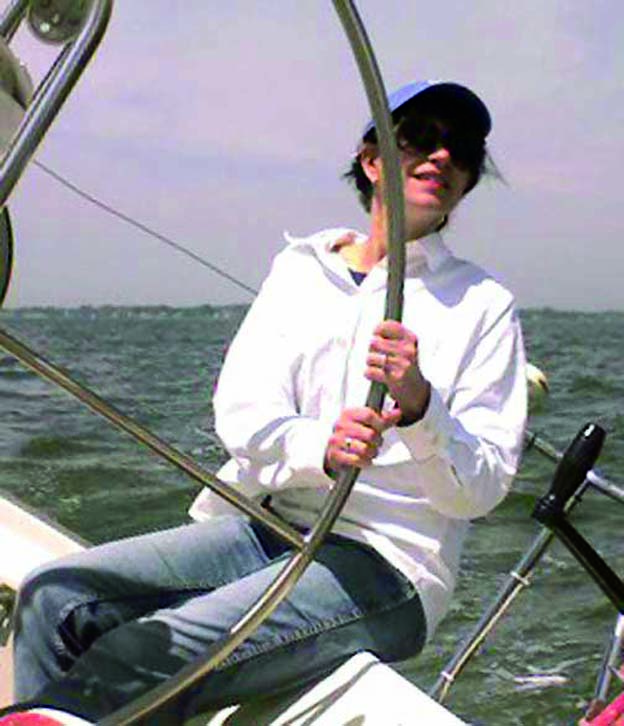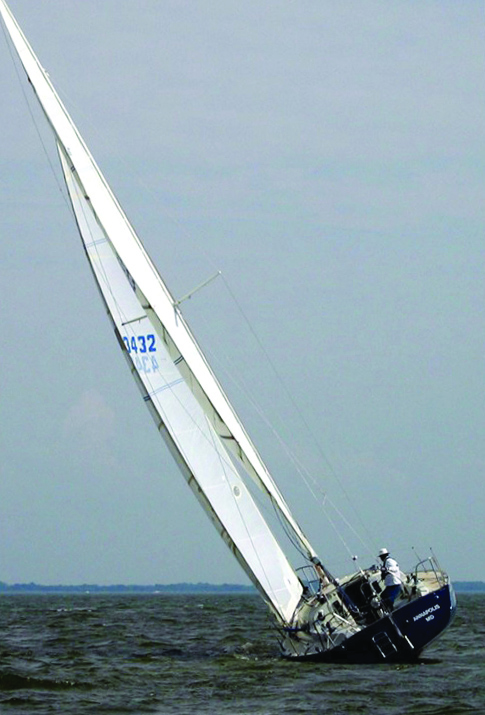Shorthanded Sailing — What Is the Worst That Can Happen?
It all began as Barbara and I were sailing home from our honeymoon. We were surfing northward in a short chop and strong summer southerly. We had gybed toward shallower water on the western shore to get out of the way of a southbound bulk carrier and a northbound tug and barge. Minutes later the helm felt funny; not quite fully connected. Out of caution, I had Barbara move aft away from the mainsheet in case we accidentally gybed. On the next course correction, the wheel was suddenly no longer attached to the rudder.

The beginning of an emergency while shorthanded is not all that different than an emergency with a full crew onboard. The first step is triage, asking yourself, “What is the worst thing that can happen?” and thinking through what other lesser things might also occur.
Quickly opening the lazarette, I checking the rudder post and seeing that no water was coming in, I concluded that the worst thing was getting run down by the ship or tug. That made keeping the boat moving priority one. I found that I could steer by hauling in the mainsheet to head up and easing the main to fall off. Barbara issued a Channel 16 VHF ‘pan-pan’ with our GPS coordinates, speed, course, description of the boat, and our limited maneuverability.
Once clear of being run down, we hove-to and began to analyze what had gone wrong, again asking “Now what is the worst that could happen and what else could go wrong?” The steering loss turned out to be a snapped 25-year-old, 20-mm diameter solid stainless steel link rod between the rack-and-pinion steering system and the rudder.
A piece of the link rod that was still attached to the rudder steering arm was whipping back and forth in the locker with such force that it was poking holes in a nearby bulkhead and threatening to hit the hull. I used a sail tie to lash the link rod to the steering arm so that it could no longer hit anything.

Thinking that everything was at least temporarily under control, I went about rigging the emergency tiller. I had practiced rigging the emergency tiller on a number of occasions, but had not actually sailed with it. I knew from practice that the wheel had to come off before I could use the emergency tiller, and had purchased a socket that fit the oversized metric nut on the wheel. I had stored that socket wrench where it was easy to find. I knew from practice that once the wheel was off, it was too big to stay in the cockpit and would need to be lashed to the grab rails on the cabintop with the couple of sail ties that I grabbed while carrying the wheel on deck. I knew that the emergency tiller lanyard was attached to an eye below the hatch next to the wheel and how to put it on the rudder head.
Not having actually sailed with the emergency tiller, I did not know that the rudder post was not keyed into the rudder head in a way that prevented the rudder from becoming unbolted and dropping out of the boat if I actually used the emergency tiller. I quickly figured that out as soon as I tried to steer home.
Again I hove-to… this time to grab my toolbox to try to MacGyver a solution. I was not able to come up with one since every time I turned to starboard the thrust nut loosened by part of a thread, and I was not able to recover all of the lost threads with a socket wrench on the nut. I considered rigging snatch blocks to the eyes for rudder stops and rigging a line through the blocks, but the eyes appeared to be too light duty.
By now, we had forereached toward shallow water and the new worst threat became running aground. Balancing the sails, we began beam reaching and by easing the jib spun head to wind. Then backing the jib, we tacked so that we began reaching away from the shoals.
As I thought ahead of the trip back home, I realized that we would need to broad reach on port tack through the fleet of Twilight racers and maneuver up the narrow channel into Mill Creek all with limited steerage. I called BoatUS for the second tow home in my sailing career. (The first was in 1964 when I lost a mast in high winds.)
While this is a very specific series of events, it none-the-less illustrates a process to address an emergency whether shorthanded or with a full crew.
The key lessons are:
- Long before an emergency happens, try to imagine what could possibly go wrong, and make sure that the boat is equipped to address that emergency. Once prepped, experiment with the equipment onboard. Part of emergency equipage may be towing insurance.
- Once an emergency begins, identify what is the greatest threat and what are secondary threats. Prioritize them quickly.
- Do not feel that you need to tackle everything at once, or even analyze everything at once. Take each part of the emergency one step at a time; realizing that priorities may change forcing you to perhaps alternate between competing threats as each alternatively becomes the most critical.
- In order to focus on the emergency, look for ways to allow the boat to take care of herself or to buy time, (such as heaving to or anchoring wherever you are). That is especially true when an injury is involved.
- Work carefully so as to not injure yourself or crewmates, or make matters worse.
- Don’t be afraid to think out of the box or do something unconventional. Don’t be afraid to
- MacGyver a solution. If you think something might work, try it, but do so carefully.
- Don’t be afraid to call for help.
Of course, the best circumstance is to try to maintain your boat in good condition and sail as prudently as you can to avoid emergencies. It is my sincere hope that you never need to deal with an emergency, but to quote that great sage, Captain Ron, “If anything is going to happen, it’s going to happen out there…”
~By Jeff Halpern
Find more safety articles here.




